Final Fantasy VII Remake offers an engaging blend of real-time combat and strategic planning. It features deep character development through rich narratives and dynamic interactions. The game showcases stunning visual innovations with advanced graphics and fluid animations. Players also face challenges in combat difficulty and resource management, enhancing the overall gameplay experience.
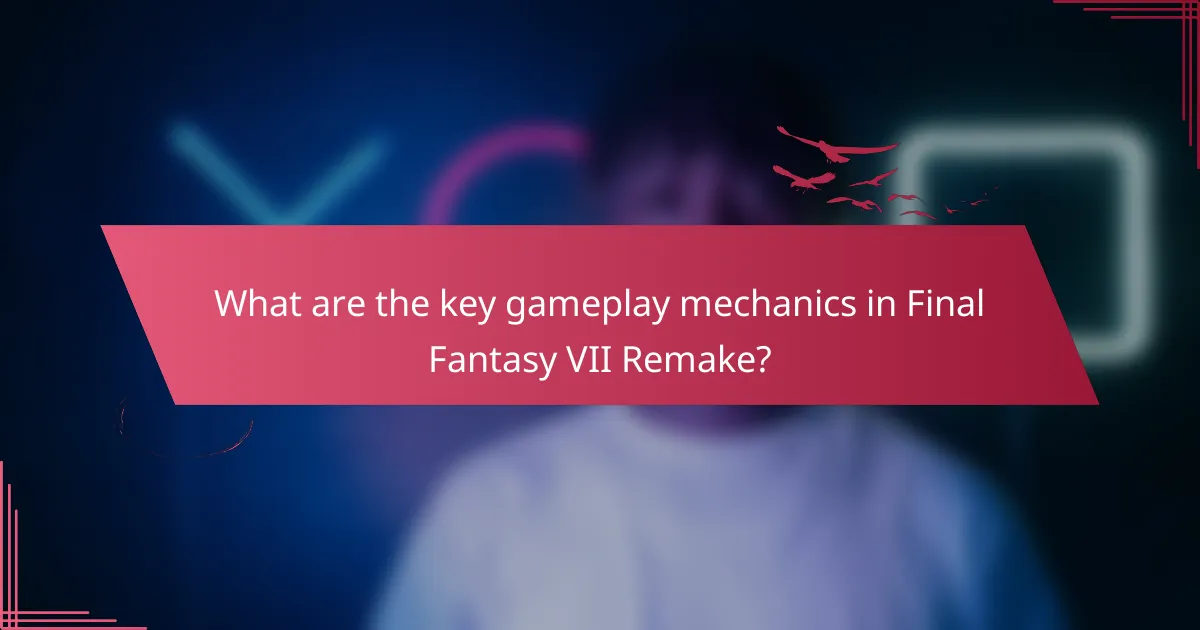
What are the key gameplay mechanics in Final Fantasy VII Remake?
Final Fantasy VII Remake features key gameplay mechanics such as real-time combat, strategic planning, and character progression. The combat system blends action and turn-based elements, allowing players to switch between characters and utilise unique abilities. Materia customisation enhances combat strategies by granting spells and skills. The game also emphasises exploration and environmental interaction, enriching the narrative experience. Character development includes deepening relationships through side quests and story arcs, enhancing player engagement.
How does the Active Time Battle system enhance combat dynamics?
The Active Time Battle system enhances combat dynamics by introducing real-time decision-making alongside traditional turn-based mechanics. This hybrid approach allows players to strategise while maintaining a fast-paced combat flow. Each character’s ATB gauge fills during battle, enabling special abilities and spells when charged. This creates a layer of depth, requiring players to balance offence and defence effectively. As a result, combat feels more engaging and responsive, fostering a dynamic experience that keeps players invested in the action.
What role do Materia and Summons play in character customisation?
Materia and Summons significantly enhance character customisation in Final Fantasy VII Remake. Materia allows players to equip spells, abilities, and stat boosts, tailoring characters to preferred play styles. Summons provide powerful allies that can be called upon during battles, adding strategic depth. The combination of these elements fosters unique character builds, enabling diverse gameplay experiences. This customisation reflects players’ choices, making each playthrough distinct and engaging.
How do environmental interactions affect gameplay strategy?
Environmental interactions significantly influence gameplay strategy in Final Fantasy VII Remake. Players must adapt their tactics based on terrain, weather, and enemy behaviour. For instance, certain areas enhance character abilities while others impose limitations.
Environmental hazards can affect combat dynamics, requiring players to navigate carefully. Utilising cover and exploiting high ground can provide strategic advantages. Additionally, some environmental elements may trigger special abilities or combos, enriching gameplay complexity.
The diverse settings encourage exploration and experimentation, promoting varied approaches to challenges. As a result, players often discover unique strategies that leverage environmental features to gain the upper hand in battles.
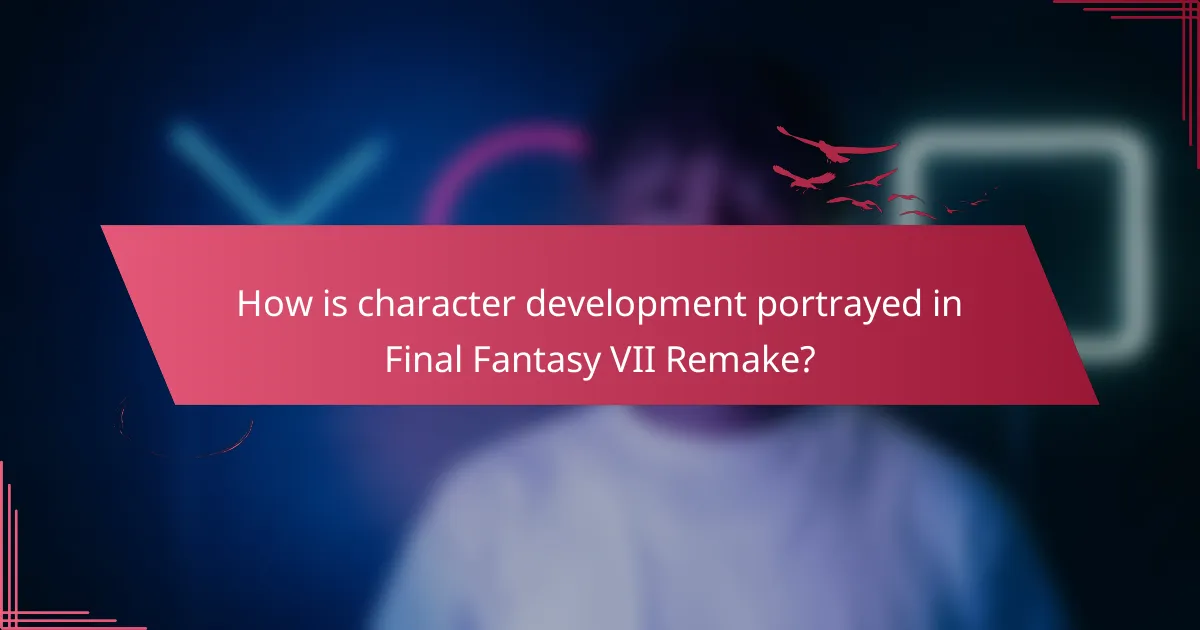
How is character development portrayed in Final Fantasy VII Remake?
Character development in Final Fantasy VII Remake is portrayed through deep narrative arcs and dynamic interactions. Each character evolves significantly, showcasing unique attributes such as personal struggles and relationships. For example, Cloud Strife’s journey from a confused mercenary to a self-aware hero illustrates profound growth. The game’s dialogue and cutscenes enhance emotional engagement, allowing players to witness characters’ transformations firsthand. Additionally, the integration of gameplay mechanics, such as character-specific abilities and interactions, further emphasises their development throughout the story.
What are the defining traits of Cloud Strife’s character arc?
Cloud Strife’s character arc in Final Fantasy VII Remake is defined by his journey from a conflicted mercenary to a heroic figure embracing his identity. Initially, Cloud struggles with his past and self-worth, often projecting a false persona. As the narrative unfolds, he confronts his memories, relationships, and the consequences of his actions. This growth is marked by his evolving bonds with characters like Aerith and Tifa, illustrating themes of friendship and redemption. Ultimately, Cloud’s arc emphasises acceptance of his true self and the importance of connection in overcoming personal demons.
How do secondary characters contribute to the overall narrative?
Secondary characters enhance the narrative by providing depth and context to the main storyline. They enrich character development, introduce unique perspectives, and create emotional stakes within “Final Fantasy VII Remake.” For example, characters like Barret and Aerith influence Cloud’s journey, revealing themes of friendship and sacrifice. Their interactions and backstories contribute to the game’s immersive world, making the experience more engaging for players. Additionally, secondary characters often drive subplots that complement the main quest, adding layers to the overall narrative structure.
What impact do player choices have on character relationships?
Player choices significantly shape character relationships in Final Fantasy VII Remake. These decisions influence dialogue options, character interactions, and emotional connections. For example, choosing to support specific characters can lead to deeper bonds or alter plot outcomes. The game’s mechanics allow for a dynamic narrative where relationships evolve based on player actions, enhancing engagement and replayability.
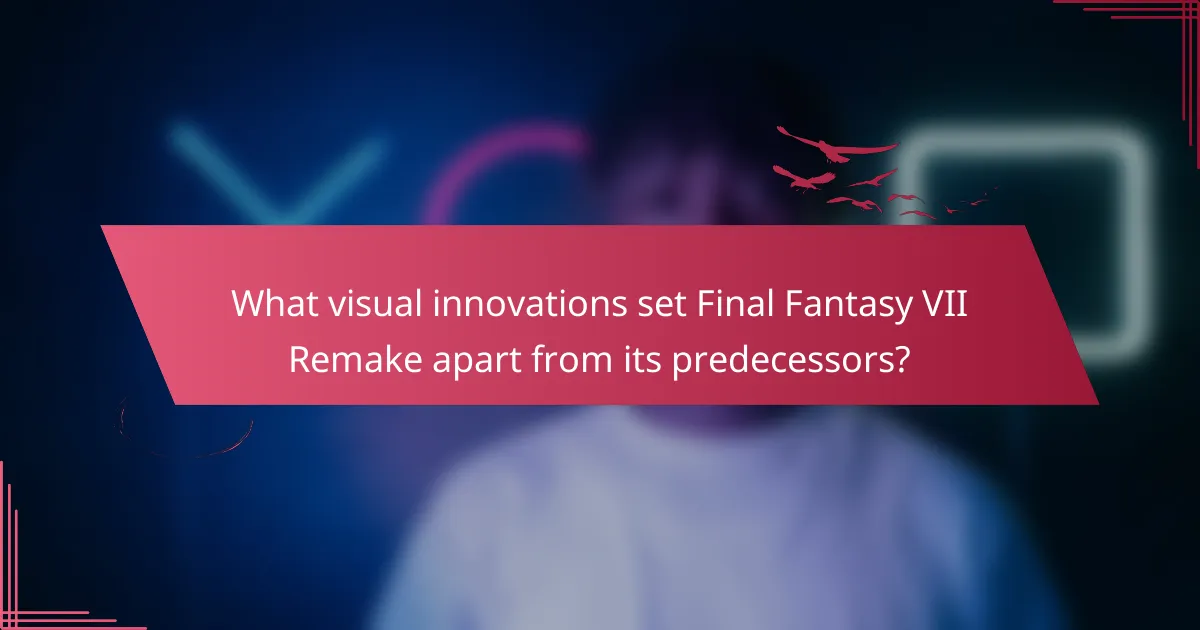
What visual innovations set Final Fantasy VII Remake apart from its predecessors?
Final Fantasy VII Remake stands out through its stunning graphics, dynamic character models, and enriched environments. The game utilises modern rendering techniques like photorealistic textures and advanced lighting systems. Character animations are more fluid, enhancing emotional expression. Additionally, the use of cinematic camera angles elevates storytelling, offering an immersive experience not seen in earlier titles.
How does the graphics engine enhance the game’s aesthetic appeal?
The graphics engine significantly enhances Final Fantasy VII Remake’s aesthetic appeal by delivering stunning visuals and immersive environments. This engine employs advanced rendering techniques, such as real-time lighting and intricate character models, which create a vibrant and dynamic world. The attention to detail in textures and animations adds depth to character interactions and combat sequences. As a result, players experience a visually captivating journey that complements the game’s narrative and emotional themes.
What role does character design play in storytelling?
Character design significantly enhances storytelling by creating relatable characters that drive emotional engagement. In “Final Fantasy VII Remake,” character design reflects the unique attributes of each character, such as Cloud’s iconic spiky hair and Buster Sword, which symbolise his internal struggles and heroism. The visual innovations in the game allow for nuanced expressions and interactions, deepening player investment in character development. As a result, effective character design not only shapes individual narratives but also enriches the overall gameplay experience, making it memorable and impactful.
How are cinematic cutscenes integrated into gameplay?
Cinematic cutscenes in Final Fantasy VII Remake are seamlessly integrated into gameplay to enhance narrative immersion. These cutscenes utilise real-time graphics, allowing transitions between gameplay and storytelling to feel fluid. Character development unfolds through these scenes, showcasing emotional depth and motivations. The visual innovations elevate the cinematic experience, with dynamic camera angles and detailed animations, creating a cohesive blend of gameplay and narrative.
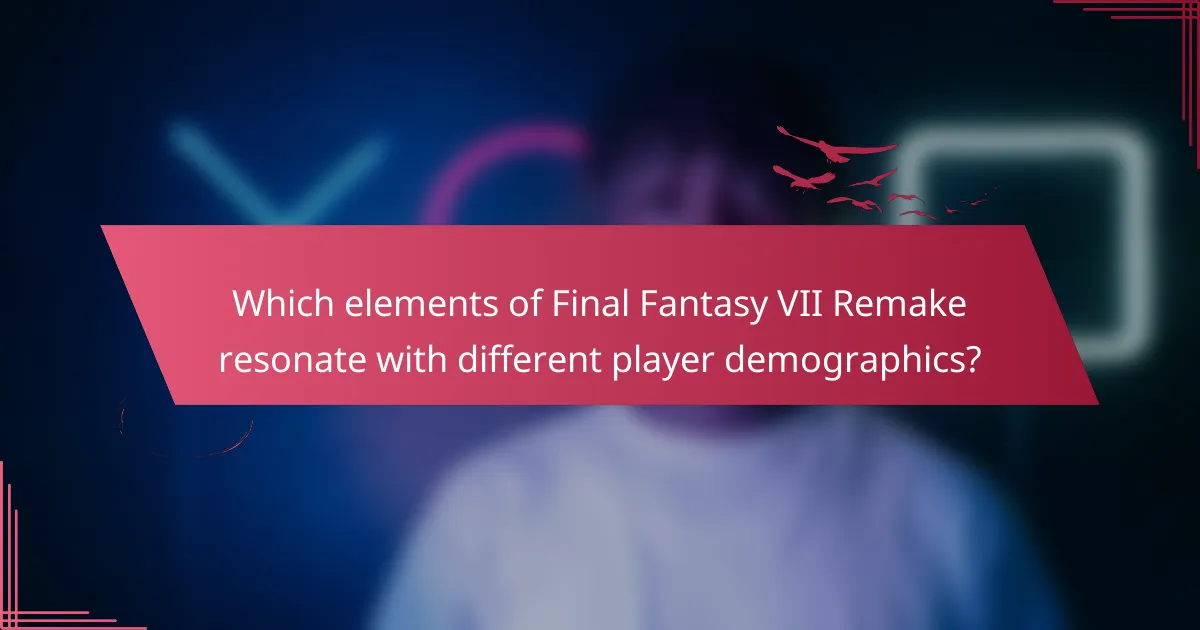
Which elements of Final Fantasy VII Remake resonate with different player demographics?
Final Fantasy VII Remake resonates with different player demographics through its engaging gameplay mechanics, rich character development, and stunning visual innovations. Younger players often appreciate the modernised combat system and graphics, while older fans value the nostalgia and character arcs. The game’s emotional storytelling appeals to those seeking deeper narratives, while casual gamers enjoy the accessibility of its mechanics. Additionally, the diverse character roster allows various demographics to find relatable figures, enhancing overall engagement.
How do cultural references influence player engagement in North America?
Cultural references significantly enhance player engagement in North America by fostering familiarity and emotional connection. Final Fantasy VII Remake incorporates iconic elements from the original game, appealing to nostalgia. This connection deepens immersion through character development and gameplay mechanics that resonate with players. Visual innovations, such as updated graphics and environmental storytelling, further amplify these cultural ties, creating a rich experience that captivates both new and returning fans.
What feedback have players in the UK provided regarding gameplay mechanics?
Players in the UK have provided positive feedback on the gameplay mechanics of Final Fantasy VII Remake, highlighting its innovative combat system and character abilities. Many appreciate the blend of real-time action and strategic planning, which enhances engagement. The character development has been noted for its depth, allowing players to form emotional connections. Visual innovations, including detailed graphics and immersive environments, further elevate the gaming experience. Overall, UK players find the gameplay mechanics refreshing and impactful, contributing to the game’s success.
How does the game’s accessibility impact its reception in Canada?
The game’s accessibility significantly enhances its reception in Canada by broadening its player base. Features like customisable controls and visual aids cater to diverse needs, making the experience inclusive. This inclusivity fosters a positive community response and encourages discussions around representation in gaming. As a result, Final Fantasy VII Remake is viewed favourably for its commitment to accessibility, appealing to both new and veteran players.
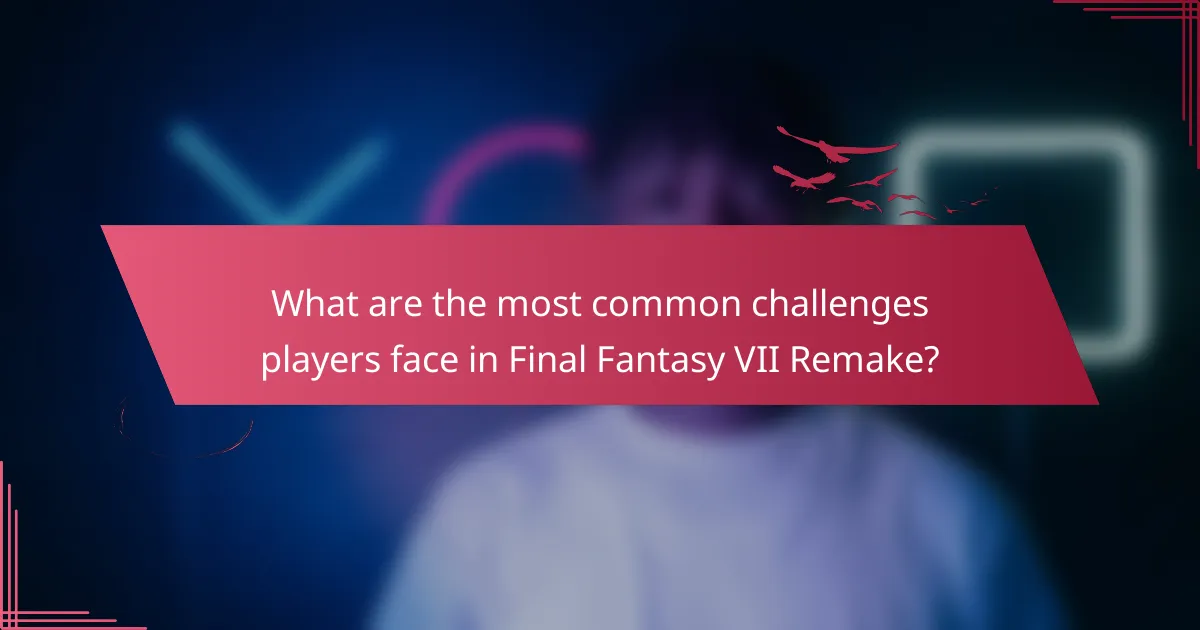
What are the most common challenges players face in Final Fantasy VII Remake?
Players in Final Fantasy VII Remake face challenges such as combat difficulty, resource management, and character progression. Combat can be intense, requiring strategic use of abilities and timing. Resource management becomes crucial, especially in managing materia and items during battles. Additionally, character progression can be complex, with players needing to balance skill upgrades and equipment choices to optimise their team. These challenges enhance the gameplay experience, pushing players to adapt and refine their strategies.
How do difficulty settings affect player experience?
Difficulty settings significantly influence player experience in Final Fantasy VII Remake. They tailor challenges to individual skill levels, enhancing engagement and satisfaction.
For casual players, lower difficulty settings provide a more accessible experience, allowing them to enjoy the story and character development without frustration. Conversely, higher difficulty settings challenge experienced players, promoting strategic gameplay and mastery of mechanics.
This balance between challenge and accessibility exemplifies the game’s unique approach to difficulty, ensuring that diverse player preferences are met. As a result, players can customise their experience, leading to varied interpretations of the game’s narrative and mechanics.
What strategies can players employ to overcome boss battles?
Players can employ several strategies to overcome boss battles in Final Fantasy VII Remake. First, understanding the boss’s attack patterns is crucial for effective dodging and countering. Utilising character abilities and materia wisely enhances damage output and support.
Timing your attacks during stagger phases maximises damage potential. Additionally, managing resources like health and limit breaks can turn the tide in challenging encounters. Experimenting with different party compositions allows for strategic flexibility, adapting to the boss’s strengths and weaknesses.
What common mistakes do players make during character progression?
Players often make mistakes in character progression by neglecting to balance their party, underutilising materia, and failing to invest in diverse abilities. These errors can hinder overall effectiveness and limit gameplay enjoyment.
One common mistake is focusing solely on a single character’s development, which can lead to an imbalanced party. Each character in Final Fantasy VII Remake has unique attributes that contribute to team dynamics.
Another frequent error is overlooking materia combinations. Players may not experiment with different setups, missing out on powerful synergies that enhance combat effectiveness.
Lastly, some players invest too heavily in a few skills while neglecting others. This can restrict versatility in battle, making it difficult to adapt to various challenges. Balancing character growth ensures a well-rounded and powerful team.
What are the best practices for maximizing Materia effectiveness?
To maximise Materia effectiveness in Final Fantasy VII Remake, players should strategically equip Materia, prioritise synergy, and enhance levels. Focus on combining offensive and support Materia for balanced combat. Leveling up Materia increases its power and unlocks new abilities. Regularly assess your party’s needs and adjust Materia accordingly to optimise performance in various encounters.


